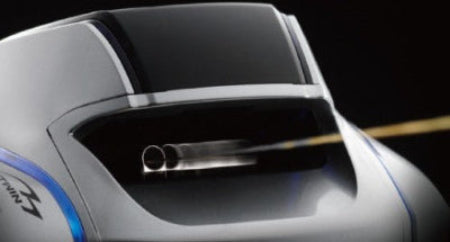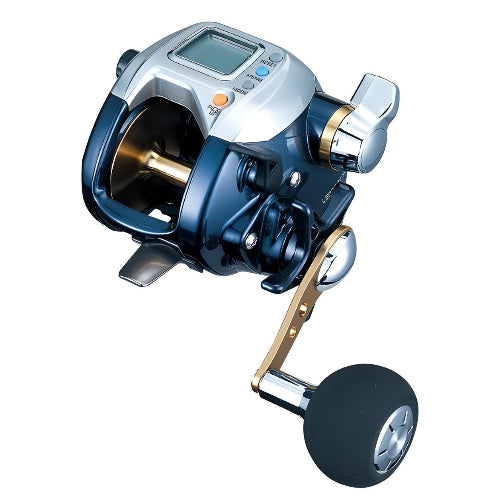Technology Features of DAIWA 2016 LEOBRITZ S400

FF STRUCTURE
The FF structure (front-motor structure) in Daiwa's electric reels offers several significant benefits by positioning the motor, which can be considered the engine of an electric reel, in front of the spool. Firstly, it allows for a more compact design by relocating the motor outside the spool, reducing the overall size and height of the reel, which enhances its maneuverability. This ergonomic improvement makes it easier for anglers to operate switches and clutches with their thumb, leading to a more comfortable fishing experience. Secondly, the independent motor enables a robust waterproofing system, allowing the reel to be washable, a feature highly appreciated by anglers who value maintaining their gear. Previously, the internal motor design made it difficult to achieve proper waterproofing, as water would enter through the gear's rotation axis, but this issue has now been resolved. Thirdly, this structure improves durability by protecting the motor from water, which, in turn, increases the motor’s lifespan. Anglers have come to recognize that washing their reels prolongs their life. Fourthly, the separation of the motor from the spool enhances cooling efficiency, as heat no longer accumulates around the spool, which used to be an issue when the motor was inside. Lastly, this design allows for smoother spool rotation, improving free spool performance and enabling the tackle to drop more quickly, offering a more agile fishing experience.

SYNCHRO LEVEL WIND
A mechanism in which the left-right oscillating movement of the level wind is synchronized with the spool rotation during both line drop and retrieval. This not only maintains an even line lay but also ensures a smoother line drop.
daiwa leobritz Spec Chart
daiwa leobritz Line-up
| Line-up | Handle | Year | Salt or Fresh | Weight(g) | Gear Ratio | Max Drag(kg) | Mono line cap. (lb-m) | Braided line cap. (lb-m) | Bearing (Ball/Roller) | Max retrieve power (kg) |
|---|---|---|---|---|---|---|---|---|---|---|
| 200J | Right | 2022 | Saltwater OK | 480 | 5.1 | 8.5 | 12-250, 16-170, 20-140 | 20-600, 30-450, 55-200 | 12/1 | 25 |
| 200JL | Left | 2022 | Saltwater OK | 480 | 5.1 | 8.5 | 12-250, 16-170, 20-140 | 20-600, 30-450, 55-200 | 12/1 | 25 |
| 300J | Right | 2023 | Saltwater OK | 540 | 5.1 | 13 | 20-280, 22-200 | 55-400, 60-300 | 12/1 | 59 |
| 300JL | Left | 2023 | Saltwater OK | 540 | 5.1 | 13 | 20-280, 22-200 | 55-400, 60-300 | 12/1 | 59 |
| S400 | Right | 2016 | Saltwater OK | 550 | 3.6 | 10 | For braided line only | 60-350, 80-300 | 4/1 | 45 |
| S500 | Right | 2016 | Saltwater OK | 740 | 2.8 | 10 | 22-330, 25-300 | 80-350, 90-300 | 6/1 | 43 |
| S500JP | Right | 2023 | Saltwater OK | 800 | 3.6 | 16 | 22-350, 25-300, 28-250 | 60-500, 80-400, 90-300 | 8/1 | 75 |
| 500JP | Right | 2020 | Saltwater OK | 815 | 3.6 | 16 | 22-350, 25-300 | 60-500, 80-400, 90-300 | 8/1 | 75 |
Specifications in Pound-Yard Notation
| Line-up | Handle | Year | Salt or Fresh | Weight(oz) | Gear Ratio | Max Drag(lb) | Mono line cap. (lb-yd) | Braided line cap. (lb-yd) | Bearing (Ball/Roller) | Max retrieve power (lb) |
|---|---|---|---|---|---|---|---|---|---|---|
| 200J | Right | 2022 | Saltwater OK | 17.1 | 5.1 | 18.9 | 12-275, 16-190, 20-155 | 20-660, 30-495, 55-220 | 12/1 | 56 |
| 200JL | Left | 2022 | Saltwater OK | 17.1 | 5.1 | 18.9 | 12-275, 16-190, 20-155 | 20-660, 30-495, 55-220 | 12/1 | 56 |
| 300J | Right | 2023 | Saltwater OK | 19.3 | 5.1 | 28.9 | 20-310, 22-220 | 55-440, 60-330 | 12/1 | 131 |
| 300JL | Left | 2023 | Saltwater OK | 19.3 | 5.1 | 28.9 | 20-310, 22-220 | 55-440, 60-330 | 12/1 | 131 |
| S400 | Right | 2016 | Saltwater OK | 19.6 | 3.6 | 22.2 | For braided line only | 60-385, 80-330 | 4/1 | 100 |
| S500 | Right | 2016 | Saltwater OK | 26.4 | 2.8 | 22.2 | 22-365, 25-330 | 80-385, 90-330 | 6/1 | 96 |
| S500JP | Right | 2023 | Saltwater OK | 0.7 | 3.6 | 35.6 | 22-385, 25-330, 28-275 | 60-550, 80-440, 90-330 | 8/1 | 167 |
| 500JP | Right | 2020 | Saltwater OK | 29.1 | 3.6 | 35.6 | 22-385, 25-330 | 60-550, 80-440, 90-330 | 8/1 | 167 |

